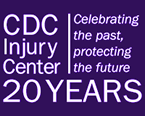Saving Lives and Protecting People:
Preventing Motor Vehicle-Related Injury
Print Version [pdf 613K]In the United States...

- Every 15 minutes, someone dies in a motor vehicle crash on U.S. roads.1
- Motor vehicle crashes kill more people ages 5 to 34 than any other cause of death.3
- Every day, eight teens die in a crash.3
- In one year alone, motor vehicle crashes cost Americans $99 billion in medical care, rehabilitation, and lost wages.4
Every day, thousands of Americans are involved in motor vehicle crashes that result in injury or death: A teenage driver killed just months after getting his license. A mother disabled in a crash when she wasn’t wearing a seat belt. An older adult injured while driving intoxicated.
The toll of motor vehicle crashes is staggering. In 2009:
- Nearly 34,000 people in the United States died in a motor vehicle crash.1
- Nearly 11,000 people died at the hands of alcohol-impaired drivers.2
- More than 12,000 of the drivers and passengers killed in motor vehicle crashes were not wearing seat belts or other restraints.1
Putting Science into Action to Reduce Motor Vehicle Crashes
CDC’s National Center for Injury Prevention and Control (Injury Center) is committed to saving lives and protecting our nation from injuries and violence.
Preventing motor vehicle-related injuries is one of the Injury Center’s focus areas. Here are just a few of the innovative strategies and strong partnerships the Injury Center uses to keep people safe on the road:
Monitoring the Problem to Inform Prevention
- The Injury Center uses in-depth data systems to document and monitor the burden of motor vehicle crashes on the nation, to identify research priorities, and to inform policies and the creation of effective, science-based prevention and intervention programs.
Prevention Works

- If every state had a strong graduated driver licensing policy, we could reduce the number of 16-year-olds involved in fatal crashes by 20%.5
- If all adult drivers in the U.S. had a blood alcohol concentration less than the illegal threshold (0.08%), nearly 7,500 lives would have been saved in 2009.6
- In 2009, seat belts and child safety seats saved more than 13,000 lives.7
Increasing Use of Seat Belts
The Injury Center has created several tools that raise awareness about the effectiveness of seat belt policies. States use these tools in their efforts to strengthen policies to address this critical injury prevention issue:
- The Vital Signs: Adult Seat Belt Use package highlights the importance of seat belt use. The Injury Center uses these materials to engage states, employers, health care professionals, and consumers in actions to increase the use of seat belts.
- Policy Impact: Seat Belts describes the scientific evidence for effective, well-enforced primary seat belt policies and outlines strategies to strengthen seat belt policies that save lives.
Keeping Teens Safe on the Road
- The Injury Center translates science into practice through communications initiatives and publications that highlight the importance of parental monitoring and strong graduated driver licensing (GDL) systems:
- Policy Impact: Teen Driver Safety describes the leading causes of teen motor vehicle crashes and details the Injury Center's policy recommendations for GDL systems.
- The Graduated Drivers License Planning Guide helps states assess their capacity for strengthening their GDL systems. The Injury Center is using the Guide as one tool in its efforts to help states that want to strengthen their GDL systems.
- The Parents Are the Key communications campaign tool kit gives parents, pediatricians, and community groups vital information and resources to help keep teens safe on the road.
Reducing Drinking and Driving
- The Injury Center supports state efforts to keep drivers sober and safe by raising awareness about alcohol-impaired driving and identifying strong policies to prevent it.
- Vital Signs: Drinking and Driving provides the latest findings on drinking and driving and issues a call to action for states, employers, health care professionals, and the public to help prevent this health threat.
- Policy Impact: Alcohol-impaired Driving details the magnitude of impaired driving and outlines the Injury Center’s recommendations for strong policies that keep alcohol-impaired drivers off the road.
- The Injury Center is partnering with the National Highway Traffic Safety Administration to evaluate state ignition interlock programs. Ignition interlocks prevent a person who has been consuming alcohol from starting a vehicle.
Improving Road Safety for Native Americans
- Building on recent successes in improving motor vehicle safety in tribal areas, the Injury Center is funding eight American Indian/Native American Tribes to design, implement, and evaluate tailored, culturally appropriate road safety interventions in their communities. Results will be used to develop a best-practices manual for U.S. tribal communities.

Motor vehicle crashes are the number one cause of death for healthy Americans who travel abroad.8
Collaborating with Global Partners
- The Injury Center works with several Latin American countries to strengthen their traffic injury data systems. For example, the Injury Center provides technical assistance on data analysis and dissemination in Peru; the methods and first results of their improved surveillance system have been published and are available as a model for other countries.
- The Injury Center supports surveillance and evaluation activities for the Global Helmet Vaccine Initiative, a campaign in Asia, Africa, and Latin America to increase motorcycle helmet use.
- The Injury Center collaborates with the United Nations and the World Health Organization to focus worldwide attention on road safety. This partnership encourages other countries to strengthen their efforts to reduce motor vehicle-related injury and death.
- Learn more about our collaborations with global partners.
CDC’s Commitment to Prevention
The Injury Center is the only U.S. federal agency that deals exclusively with injury and violence prevention in non-occupational settings. It leads a coordinated public health approach to tackling this critical health and safety issue.
The Injury Center is committed to continuing its work to prevent motor vehicle-related injuries and deaths, in close partnership with other federal agencies. Prevention is the most effective, common-sense way to improve health and lower the societal costs of medical care and other negative effects related to motor vehicle crashes. Our priority is to equip states, territories, tribal areas, and global communities with the best science, tools, and resources so that they can take effective actions to keep people safe on the roads—every day.
Join us in making injury and violence prevention the premier public health achievement of the next decade!
More Information
For more information about motor vehicle-related injuries, go to www.cdc.gov/motorvehiclesafety, and Like us on Facebook, www.facebook.com/cdcparentsarethekey.
Learn More
References
- U.S. Department of Transportation, National Highway Traffic Safety Administration (NHTSA). Traffic Safety Facts: Highlights of 2009 Motor Vehicle Crashes. Table 5. Washington (DC): NHTSA; 2010. [accessed 2001 Dec 14]. Available from: http://www-nrd.nhtsa.dot.gov/Pubs/811363.PDF
- Centers for Disease Control and Prevention. Drinking and Driving: A Threat to Everyone. [updated 2011 Oct 4; accessed 2011 Nov 1]. Available from: http://www.cdc.gov/vitalsigns/drinkinganddriving/?s_cid=vitalsigns-092-bb.
- Centers for Disease Control and Prevention. Web-based Injury Statistics Query and Reporting System (WISQARS). Atlanta, GA [updated 2011 Feb 24; accessed 2011 Nov 1]. Available from: http://www.cdc.gov/injury/wisqars.
- Naumann RB, Dellinger AM, Zaloshnja E, Lawrence BA, Miller TR. 2010. Incidence and total lifetime costs of motor vehicle–related fatal and nonfatal injury by road user type, United States, 2005. Traffic Inj Prev 11:353–60. Also see Centers for Disease Control and Prevention. CDC Vital Signs. Adult Seat Belt Use in the US: Latest Findings. [updated 2011 Jan 4; accessed 2011 Nov 10]. Available from: http://www.cdc.gov/VitalSigns/SeatBeltUse/LatestFindings.html
- Chen L-H, Baker SP, Li G. 2006. Graduated driver licensing programs and fatal crashes of 16-year-old drivers: A national evaluation. Pediatrics 118:56-62.
- Insurance Institute for Highway Safety/Highway Loss Data Institute. Fatality Facts 2009: Alcohol. [accessed 2011 Dec 14]. Available from: http://www.iihs.org/research/fatality_facts_2009/alcohol.html.
- U.S. Department of Transportation, National Highway Traffic Safety Administration (NHTSA). Traffic Safety Facts: 2009 Data. Occupant Protection. Washington (DC): NHTSA; 2011. [accessed 2011 Dec 14]. Available from: http://www-nrd.nhtsa.dot.gov/Pubs/811390.pdf .
- Centers for Disease Control and Prevention. CDC Activities: Global Road Safety. [updated 2010 Aug 31; accessed 2011 Nov 23]. Available from: http://www.cdc.gov/Motorvehiclesafety/global/research.html.
Get email updates
To receive email updates about this page, enter your email address:
Contact Us:
- Centers for Disease Control and Prevention
National Center for Injury Prevention and Control (NCIPC)
4770 Buford Hwy, NE
MS F-63
Atlanta, GA 30341-3717 - 800-CDC-INFO
(800-232-4636)
TTY: (888) 232-6348
New Hours of Operation:
8am-8pm ET/
Monday-Friday
Closed Holidays - cdcinfo@cdc.gov




